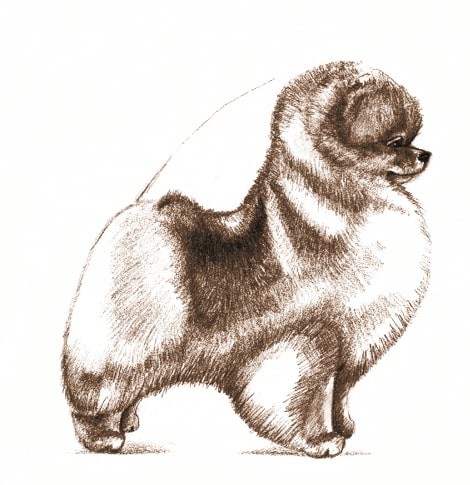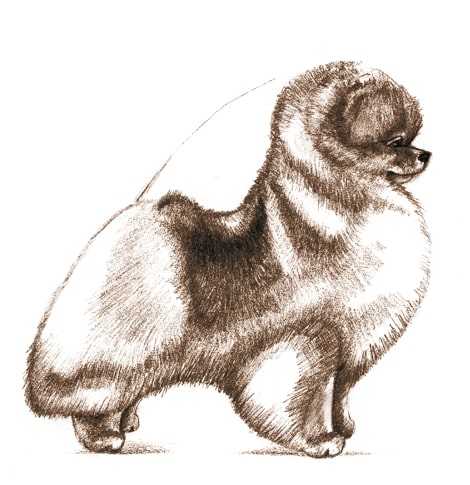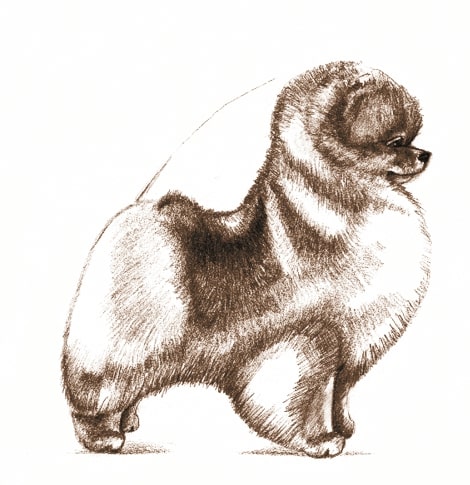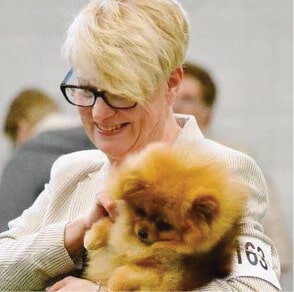
Home » Trimming the Pomeranian | Circular Outline

It would seem that in the Pomeranian ring, the most controversial subject is trimming. Breeders, judges, handlers, and exhibitors all have an opinion, and all have their own style of trimming. Let’s look at why the Pom is trimmed the way it is—or should be.
First of all, we need to remember that the Pomeranian is a member of the Spitz family, and all of those breeds, the Samoyed, the Keeshond, the Finnish Spitz, etc., have a common coat type; harsh outer guard hairs, coarse to the touch, and a shorter, softer undercoat. This type of coat is, unfortunately, as hard to trim as it is to find.
The Pomeranian also has the same basic body type as its larger cousins. As with most Spitz breeds, Poms are not over-angulated. The AKC Breed Standard is explicit about body shape; “compact, short-backed” (not short on leg). It is important to keep this round shape in mind when judging the breed. If the legs are mounted correctly, i.e., nicely set under the body in front and not covering too much ground behind, the Pom is well on its way to fit into that shape.


The “fads” of trimming Poms, as in many other breeds, come and go. The newest, and probably the scariest, fad is the idea that a Pomeranian outline should resemble a triangle. The shape of a Pom is the very essence of the breed. It is a circle. Some may see the Pom as a square within a circle, but the Pomeranian outline, standing and/or moving, is definitely not a triangle. A far greater concern with promoting this triangle shape is that it encourages a body type that suggests the dog should cover more ground. The one thing we do not want to encourage is a Pom with a straight front or over-angulated rear. The shape of the Pomeranian is basic to the breed, and it is round.
The Tail: Another very important characteristic in this breed is the tail; “heavily plumed, set high and lies flat and straight on the back.” It is mentioned in the Standard twice this way. It is also mentioned in the Coat section of the Standard: “Tail is profusely covered with long, harsh, spreading, straight hair forming a plume.” Good tails and tail sets are hard to find and hard to breed, but a beautiful tail contributes greatly to the overall shape of the dog. To check the tail set, you should be able to put your hand flat against the “pin bones” of the dog and not feel the tail protruding into your hand. A low tail set is a major fault. It ruins the outline and appears as an afterthought, protruding past the circular outline. A common mistake is to trim all the hair from around the tail, exposing the tail bone and ruining the outline. The tail should be the “finish” and main a part of the outline.
The Pants: Keep your pants on! Again, this is an important characteristic of the breed. Some people feel that trimming pants off too high or above the hock, or at odd 45-degree angles, shortens the body. But the pants, properly blended into the body coat with the help of a long, full tail, contribute to the circular shape and outline we are trying to present. The pants give the dog “finish” to the shape, so why cut them off? Keeping the pants on often helps to make the tail set look better as well. An overly scissored body coat, and a short, low tail set, is offensive to this beautiful, full-coated breed.
Forequarters: “The coat should form a ruff around the neck, framing the head…” This should indicate that the ruff, again, contributes to that rounded appearance. The chest, as well, blends into that ruff, creating a “finish.” There should never be breaks or obvious angles in the outline. The ruff fits into the chest, and the feather on the back of the legs should be a soft transition from the legs into tiny feet. They should not be trimmed up, leaving a part of the legs or feet exposed. The outline should always be soft, blending from one part to the next.
In conclusion, I would say that there appears to be three ways to trim the Pomeranian: Badly, i.e., the dog is trimmed in a manner that leaves too much coat in the wrong places, detracting from the correct outline; Over Trimming, removing too much coat to the point that the harsh outer coat cannot even be detected, destroying the correct outline; Trimmed Correctly, leaving sufficient coat to evaluate the double coat and tidying up where necessary to accentuate the correct outline.
Trimming the Pomeranian | Circular Outline
